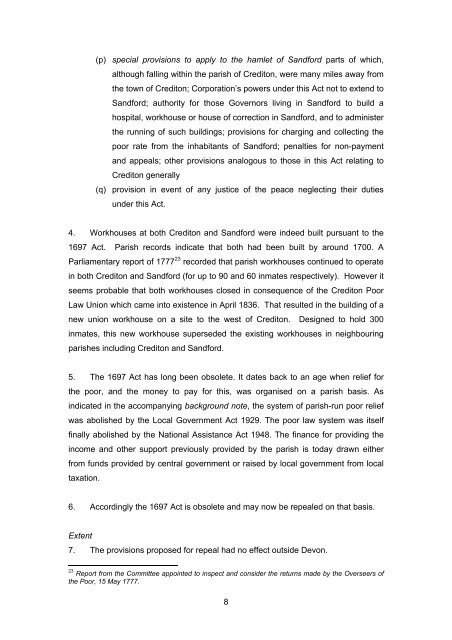Poor Relief - Law Commission
Poor Relief - Law Commission
Poor Relief - Law Commission
You also want an ePaper? Increase the reach of your titles
YUMPU automatically turns print PDFs into web optimized ePapers that Google loves.
(p) special provisions to apply to the hamlet of Sandford parts of which,<br />
although falling within the parish of Crediton, were many miles away from<br />
the town of Crediton; Corporation’s powers under this Act not to extend to<br />
Sandford; authority for those Governors living in Sandford to build a<br />
hospital, workhouse or house of correction in Sandford, and to administer<br />
the running of such buildings; provisions for charging and collecting the<br />
poor rate from the inhabitants of Sandford; penalties for non-payment<br />
and appeals; other provisions analogous to those in this Act relating to<br />
Crediton generally<br />
(q) provision in event of any justice of the peace neglecting their duties<br />
under this Act.<br />
4. Workhouses at both Crediton and Sandford were indeed built pursuant to the<br />
1697 Act. Parish records indicate that both had been built by around 1700. A<br />
Parliamentary report of 1777 23 recorded that parish workhouses continued to operate<br />
in both Crediton and Sandford (for up to 90 and 60 inmates respectively). However it<br />
seems probable that both workhouses closed in consequence of the Crediton <strong>Poor</strong><br />
<strong>Law</strong> Union which came into existence in April 1836. That resulted in the building of a<br />
new union workhouse on a site to the west of Crediton. Designed to hold 300<br />
inmates, this new workhouse superseded the existing workhouses in neighbouring<br />
parishes including Crediton and Sandford.<br />
5. The 1697 Act has long been obsolete. It dates back to an age when relief for<br />
the poor, and the money to pay for this, was organised on a parish basis. As<br />
indicated in the accompanying background note, the system of parish-run poor relief<br />
was abolished by the Local Government Act 1929. The poor law system was itself<br />
finally abolished by the National Assistance Act 1948. The finance for providing the<br />
income and other support previously provided by the parish is today drawn either<br />
from funds provided by central government or raised by local government from local<br />
taxation.<br />
6. Accordingly the 1697 Act is obsolete and may now be repealed on that basis.<br />
Extent<br />
7. The provisions proposed for repeal had no effect outside Devon.<br />
23<br />
Report from the Committee appointed to inspect and consider the returns made by the Overseers of<br />
the <strong>Poor</strong>, 15 May 1777.<br />
8
















